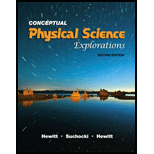
According to nebular theory, what happens to a nebula as it contracts under the force of gravity?
The effect to a nebula when it contracts under the force of gravity?
Answer to Problem 1TE
When nebula contract under the force of gravity it spins faster and continuous spinning makes it flattens out into solar system.
Explanation of Solution
According to the nebular theory, it is proposed that the solar system is made by the cloud of gas and dust. These clouds are very large with a diameter of a billion kilometre, which is a thousand times larger than the diameter of Neptune.
These clouds collide because of the effect of gravity. This collapse began slowly, but as the particle come closer to each other, the effect of gravity increases and this process accelerate. The gravitational force causes a nebula to contract, as gravity force increases, it took the shape of a sphere. As the nebula contract, it spins faster, with its continuous spinning motion it becames flattened.
Conclusion:
Therefore, when nebula contract under the force of gravity it spins faster and continuous spinning makes it flattens out into solar system.
Chapter 32 Solutions
Conceptual Physical Science Explorations
Additional Science Textbook Solutions
The Cosmic Perspective Fundamentals (2nd Edition)
College Physics
The Cosmic Perspective
An Introduction to Thermal Physics
University Physics with Modern Physics (14th Edition)
Essential University Physics: Volume 2 (3rd Edition)
 College PhysicsPhysicsISBN:9781305952300Author:Raymond A. Serway, Chris VuillePublisher:Cengage Learning
College PhysicsPhysicsISBN:9781305952300Author:Raymond A. Serway, Chris VuillePublisher:Cengage Learning University Physics (14th Edition)PhysicsISBN:9780133969290Author:Hugh D. Young, Roger A. FreedmanPublisher:PEARSON
University Physics (14th Edition)PhysicsISBN:9780133969290Author:Hugh D. Young, Roger A. FreedmanPublisher:PEARSON Introduction To Quantum MechanicsPhysicsISBN:9781107189638Author:Griffiths, David J., Schroeter, Darrell F.Publisher:Cambridge University Press
Introduction To Quantum MechanicsPhysicsISBN:9781107189638Author:Griffiths, David J., Schroeter, Darrell F.Publisher:Cambridge University Press Physics for Scientists and EngineersPhysicsISBN:9781337553278Author:Raymond A. Serway, John W. JewettPublisher:Cengage Learning
Physics for Scientists and EngineersPhysicsISBN:9781337553278Author:Raymond A. Serway, John W. JewettPublisher:Cengage Learning Lecture- Tutorials for Introductory AstronomyPhysicsISBN:9780321820464Author:Edward E. Prather, Tim P. Slater, Jeff P. Adams, Gina BrissendenPublisher:Addison-Wesley
Lecture- Tutorials for Introductory AstronomyPhysicsISBN:9780321820464Author:Edward E. Prather, Tim P. Slater, Jeff P. Adams, Gina BrissendenPublisher:Addison-Wesley College Physics: A Strategic Approach (4th Editio...PhysicsISBN:9780134609034Author:Randall D. Knight (Professor Emeritus), Brian Jones, Stuart FieldPublisher:PEARSON
College Physics: A Strategic Approach (4th Editio...PhysicsISBN:9780134609034Author:Randall D. Knight (Professor Emeritus), Brian Jones, Stuart FieldPublisher:PEARSON





